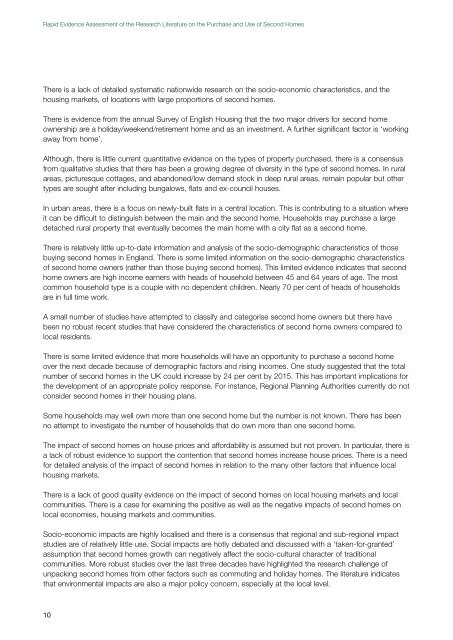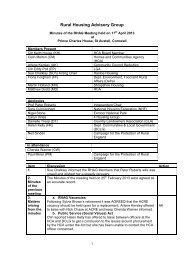Rapid Evidence Assessment of the Research ... - Rural Housing
Rapid Evidence Assessment of the Research ... - Rural Housing
Rapid Evidence Assessment of the Research ... - Rural Housing
You also want an ePaper? Increase the reach of your titles
YUMPU automatically turns print PDFs into web optimized ePapers that Google loves.
<strong>Rapid</strong> <strong>Evidence</strong> <strong>Assessment</strong> <strong>of</strong> <strong>the</strong> <strong>Research</strong> Literature on <strong>the</strong> Purchase and Use <strong>of</strong> Second Homes<br />
There is a lack <strong>of</strong> detailed systematic nationwide research on <strong>the</strong> socio-economic characteristics, and <strong>the</strong><br />
housing markets, <strong>of</strong> locations with large proportions <strong>of</strong> second homes.<br />
There is evidence from <strong>the</strong> annual Survey <strong>of</strong> English <strong>Housing</strong> that <strong>the</strong> two major drivers for second home<br />
ownership are a holiday/weekend/retirement home and as an investment. A fur<strong>the</strong>r significant factor is ‘working<br />
away from home’.<br />
Although, <strong>the</strong>re is little current quantitative evidence on <strong>the</strong> types <strong>of</strong> property purchased, <strong>the</strong>re is a consensus<br />
from qualitative studies that <strong>the</strong>re has been a growing degree <strong>of</strong> diversity in <strong>the</strong> type <strong>of</strong> second homes. In rural<br />
areas, picturesque cottages, and abandoned/low demand stock in deep rural areas, remain popular but o<strong>the</strong>r<br />
types are sought after including bungalows, flats and ex-council houses.<br />
In urban areas, <strong>the</strong>re is a focus on newly-built flats in a central location. This is contributing to a situation where<br />
it can be difficult to distinguish between <strong>the</strong> main and <strong>the</strong> second home. Households may purchase a large<br />
detached rural property that eventually becomes <strong>the</strong> main home with a city flat as a second home.<br />
There is relatively little up-to-date information and analysis <strong>of</strong> <strong>the</strong> socio-demographic characteristics <strong>of</strong> those<br />
buying second homes in England. There is some limited information on <strong>the</strong> socio-demographic characteristics<br />
<strong>of</strong> second home owners (ra<strong>the</strong>r than those buying second homes). This limited evidence indicates that second<br />
home owners are high income earners with heads <strong>of</strong> household between 45 and 64 years <strong>of</strong> age. The most<br />
common household type is a couple with no dependent children. Nearly 70 per cent <strong>of</strong> heads <strong>of</strong> households<br />
are in full time work.<br />
A small number <strong>of</strong> studies have attempted to classify and categorise second home owners but <strong>the</strong>re have<br />
been no robust recent studies that have considered <strong>the</strong> characteristics <strong>of</strong> second home owners compared to<br />
local residents.<br />
There is some limited evidence that more households will have an opportunity to purchase a second home<br />
over <strong>the</strong> next decade because <strong>of</strong> demographic factors and rising incomes. One study suggested that <strong>the</strong> total<br />
number <strong>of</strong> second homes in <strong>the</strong> UK could increase by 24 per cent by 2015. This has important implications for<br />
<strong>the</strong> development <strong>of</strong> an appropriate policy response. For instance, Regional Planning Authorities currently do not<br />
consider second homes in <strong>the</strong>ir housing plans.<br />
Some households may well own more than one second home but <strong>the</strong> number is not known. There has been<br />
no attempt to investigate <strong>the</strong> number <strong>of</strong> households that do own more than one second home.<br />
The impact <strong>of</strong> second homes on house prices and affordability is assumed but not proven. In particular, <strong>the</strong>re is<br />
a lack <strong>of</strong> robust evidence to support <strong>the</strong> contention that second homes increase house prices. There is a need<br />
for detailed analysis <strong>of</strong> <strong>the</strong> impact <strong>of</strong> second homes in relation to <strong>the</strong> many o<strong>the</strong>r factors that influence local<br />
housing markets.<br />
There is a lack <strong>of</strong> good quality evidence on <strong>the</strong> impact <strong>of</strong> second homes on local housing markets and local<br />
communities. There is a case for examining <strong>the</strong> positive as well as <strong>the</strong> negative impacts <strong>of</strong> second homes on<br />
local economies, housing markets and communities.<br />
Socio-economic impacts are highly localised and <strong>the</strong>re is a consensus that regional and sub-regional impact<br />
studies are <strong>of</strong> relatively little use. Social impacts are hotly debated and discussed with a ‘taken-for-granted’<br />
assumption that second homes growth can negatively affect <strong>the</strong> socio-cultural character <strong>of</strong> traditional<br />
communities. More robust studies over <strong>the</strong> last three decades have highlighted <strong>the</strong> research challenge <strong>of</strong><br />
unpacking second homes from o<strong>the</strong>r factors such as commuting and holiday homes. The literature indicates<br />
that environmental impacts are also a major policy concern, especially at <strong>the</strong> local level.<br />
10






